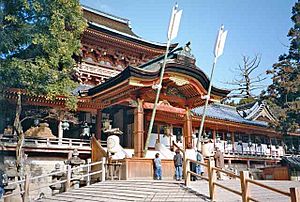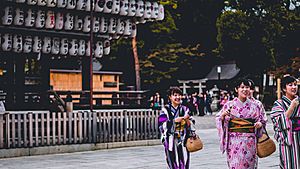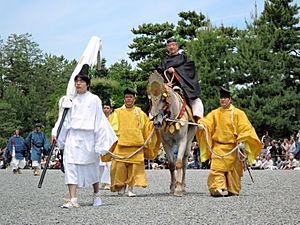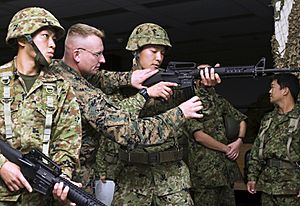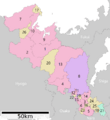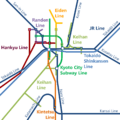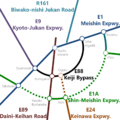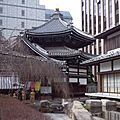Kyoto Prefecture facts for kids
Quick facts for kids
Kyoto Prefecture
|
|||
|---|---|---|---|
|
|||
 |
|||
| Country | Japan | ||
| Region | Kansai | ||
| Island | Honshu | ||
| Capital | Kyoto | ||
| Subdivisions | Districts: 6, Municipalities: 26 | ||
| Area | |||
| • Total | 4,612.19 km2 (1,780.78 sq mi) | ||
| Area rank | 31st | ||
| Population
(October 1, 2015)
|
|||
| • Total | 2,610,353 | ||
| • Rank | 13th | ||
| • Density | 566/km2 (1,470/sq mi) | ||
| ISO 3166 code | JP-26 | ||
| Website | www.pref.kyoto.jp | ||
| Symbols | |||
| Bird | Streaked shearwater (Calonectris leucomelas) | ||
| Flower | Weeping cherry blossom (Prunus spachiana) | ||
| Tree | Kitayama Sugi (Cryptomeria japonica) | ||
Kyoto Prefecture is a prefecture of Japan in the Kansai region of the island of Honshu. Its capital is the city of Kyoto.
Contents
History
Until the Meiji Restoration, the area of Kyoto Prefecture was known as Yamashiro.
For most of its history, the city of Kyoto was Japan's Imperial capital. The city's history can be traced back as far as the 6th century. In 544, the Aoi Matsuri was held in Kyoto to pray for good harvest and good weather.
Kyoto did not start out as Japan's capital. An earlier capital was Nara. In 741, Emperor Shōmu moved the capital briefly to Kuni-kyo, between the cities of Nara and Kyoto, in present-day Kyoto Prefecture.
In 784, the capital was moved to Nagaokakyō, also in present-day Kyoto Prefecture. In 794, Emperor Kanmu moved the capital to Heian-kyō, and this was the beginning of the current-day city of Kyoto. Even today, almost all of the streets, houses, stores, temples and shrines in Kyoto exist where they were placed in this year.

In 1467, a great civil war, the Ōnin War, took place inside Kyoto, and most of the town was burned down. Japan plunged into the age of warring feudal lords. A new strong man, Tokugawa Ieyasu, established the shogunate at Edo (today's Tokyo) in 1603.
In the 15th century AD, tea-jars were brought by the shōguns to Uji in Kyoto from the Philippines which was used in the Japanese tea ceremony.
The Meiji Restoration returned Japan to imperial rule in 1868. Emperor Meiji, who was now the sovereign, went to stay in Tokyo during the next year. The imperial court has not returned to Kyoto since then.
During the instigation of Fuhanken Sanchisei in 1868, the prefecture was reorganized and the old provincial system merged the former Tango Province, Yamashiro Province and the eastern part of Tanba Province into today's Kyoto Prefecture.
Although many Japanese major cities were heavily bombed by U.S. bombers during World War II, the old capital escaped such devastating bombing. During the occupation, the U.S. Sixth Army was headquartered in Kyoto.
Geography
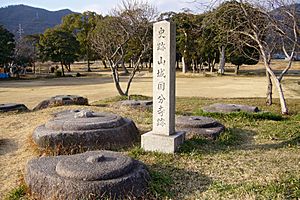
Kyoto Prefecture is almost in the center of Honshu and of Japan. It covers an area of 4,612.19 square kilometres (1,780.78 sq mi), which is 1.2% of Japan. Kyoto is 31st by size. To the north, it faces the Sea of Japan and Fukui Prefecture.
To the south, it faces Osaka and Nara Prefectures. To the east, it faces Mie and Shiga Prefectures. To its west is Hyōgo Prefecture. The prefecture is separated in the middle by the Tanba Mountains. This makes its climate very different in the north and south.
As of 15 April 2016, 21% of the prefecture's land area was designated as Natural Parks.
Economy
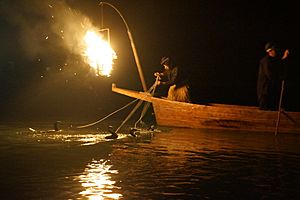
Kyoto prefecture's economy is supported by industries that create value that is unique to Kyoto, such as the tourism and traditional industries supported by 1,200 years of history and culture, as well as high-technology industries that combine the technology of Kyoto's traditional industries with new ideas.
Northern Kyoto on the Tango Peninsula has fishing and water transportation, and midland Kyoto has agriculture and forestry. The prefecture produces 13% of the domestic sake and green tea. Japan's largest vertical farm is located in the prefecture.
Culture
Kyoto has been, and still remains, Japan's cultural center. For over 1000 years it was Japan's capital. When the capital was changed to Tokyo, Kyoto remained Japan's cultural capital.
The local government proposes a plan to move the Agency for Cultural Affairs to Kyoto and to regard Tokyo as the capital of politics and economy and Kyoto as the capital of culture.
Tourism
The city of Kyoto is one of the most popular tourist spots in Japan, and many people from far and wide visit there. Along with Tokyo, Kyoto is a favorite location for the graduation trip of Junior High and High schools.
Some of the festivals held in Kyoto are Aoi Matsuri from 544, Gion Matsuri from 869, Ine Matsuri from the Edo-era, Daimonji Gozan Okuribi from 1662, and Jidai Matsuri from 1895.
Every shrine and temple holds some sort of event, and many of them are open for public viewing.
Defense facilities
On August 1, 2013 authorities gave consent for a USFJ missile monitoring station to be set up in the city of Kyōtango. It will be co-located with a JASDF facility already based in the city.

Initially, its primary sensor will be a mobile X-band radar used to gather data on ballistic missile launches which will then be relayed by the station to warships equipped with Aegis air defense systems and to ground-based interceptor missile sites. A hundred and sixty personnel will be based at the station.
Related pages
- Provinces of Japan
- Prefectures of Japan
- List of regions of Japan
- List of islands of Japan
- Kyoto Sanga F.C.
Images for kids
-
Nagaoka-kyō, a Capital of Japan in Otokuni Palace
-
Map of Kyoto Prefecture Designated City City Town Village
-
Tōkaidō Shinkansen arriving at Kyoto Station
-
Japanese tea plantation
-
Rokkaku-dō, where a school of the Japanese flower arrangement originated from.
See also
 In Spanish: Prefectura de Kioto para niños
In Spanish: Prefectura de Kioto para niños




